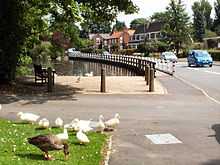Walkington
| Walkington | |
 Walkington | |
| Population | 2,337 (2011 census)[1] |
|---|---|
| OS grid reference | SE996371 |
| Civil parish | Walkington |
| Unitary authority | East Riding of Yorkshire |
| Ceremonial county | East Riding of Yorkshire |
| Region | Yorkshire and the Humber |
| Country | England |
| Sovereign state | United Kingdom |
| Post town | BEVERLEY |
| Postcode district | HU17 |
| Dialling code | 01482 |
| Police | Humberside |
| Fire | Humberside |
| Ambulance | Yorkshire |
| EU Parliament | Yorkshire and the Humber |
| UK Parliament | Beverley and Holderness |
Walkington is a village and civil parish in the East Riding of Yorkshire, England. It is situated approximately 3 miles (4.8 km) to the south-west of the town of Beverley on the B1230 road.
The civil parish is formed by the village of Walkington and the hamlet of Broadgate. According to the 2011 UK census, Walkington parish had a population of 2,337,[1] a reduction on the 2001 UK census figure of 2,481.[2]
The village is the former home of a mental asylum, named Broadgate Hospital, built on the grounds of a Broadgate Farm, and opened in 1871. The hospital closed in 1989 to make way for private housing developments, which is known as "Broadgates" by locals. Broadgate Farm which is located between the village of Walkington and the Broadgates housing estate has now been developed into a complex of holiday cottages named Broadgate Farm Cottages.
The village has three public houses located along the main road, East End. From West to East, these are the Dog and Duck, the Ferguson Fawsitt Arms and the Barrel.

In the centre of Walkington is the village pond, which can be seen to be a major focal point for the residents of the village.
The village school is situated in Crake Wells, a minor street in the East End of the village. Before the year 1999 the school was divided between two sites which included the original school house at Northgate which dates back to the late 19th century. However, after a costly extension to the Crake Wells building, the infant and junior sections were finally joined together in time for the 1999–2000 school year. The new building was officially opened by then Education Secretary David Blunkett, in October 1999.[3]
The parish church of All Hallows is a Grade II* listed building.[4]
A few miles west of Walkington is the Bronze Age barrow complex of Walkington Wold. The remains there include the decapitated remains of Anglo-Saxon criminals.[5]
To the east of the village is one of the medieval stone boundary markers for the sanctuary of Saint John of Beverley that is now a Scheduled Ancient Monument.[6]
References
- ↑ 1.0 1.1 "Key Figures for 2011 Census: Key Statistics: Area: Walkington CP (Parish)". Neighbourhood Statistics. Office for National Statistics. Retrieved 7 February 2013.
- ↑ "2001 Census: Key Statistics: Parish Headcounts: Area: Walkington CP (Parish)". Neighbourhood Statistics. Office for National Statistics. Retrieved 20 May 2008.
- ↑ "About Us". Walkington Primary School. Retrieved 21 September 2013.
- ↑ English Heritage. "Church of All Hallows (1161425)". National Heritage List for England. Retrieved 7 February 2013.
- ↑ "Grisly discovery of headless bodies gives insight into justice Saxon style". Yorkshire Post. 31 December 2007. Retrieved 12 February 2011.
- ↑ English Heritage. "Beverley sanctuary limit stone, Walkington cross (1012591)". National Heritage List for England. Retrieved 21 September 2013.
- Gazetteer — A–Z of Towns Villages and Hamlets. East Riding of Yorkshire Council. 2006. p. 11.
External links
| Wikimedia Commons has media related to Walkington. |
- Walkington Village News
- Walkington Primary School
- The Walkington Society
- Details from listed building database (164605) . Images of England. English Heritage. - All Hallows' Church
- Walkington in the Domesday Book